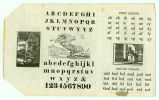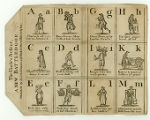Magazines, Chapbooks, Copybooks, Battledores & Hornbooks
Magazines
 |
CHILDREN'S MAGAZINE. New York: General Protestant Episcopal Sunday S. Union and Church Book Society, Vol. XXXI, March, 1859. Chapbook format with woodcut illustrations, uncolored. Includes articles : "Meals in the East," "Indian Children," "Christ Church, Hudson," "The Lotus," and "Love Your Enemies". Exhibit checklist 2.1 (View this item) |
Chapbooks
Chapbooks were "cheap" single-signature booklets of from eight to 32 pages sold by itinerant peddlers from carts and trays, who roamed the rural communities of England and New England. Along with sewing notions, small household items, and broadsides, these paperbound books provided the denizens of small towns with the latest tales, gossip and news. Gradually, the books became larger but they continued to be bound in flimsy paper, were illustrated with crude woodcuts, often repeated, and sold for a penny each or less.
Stories of unrequited love, crimes, heroic feats, fairy tales, nursery rhymes and religious tracts nourished the newly literate populace. The chapbooks numbered in the thousands, sometimes hand-colored but more often plain. They were written for adults as well as children. Because of their fragile nature, few have survived and those that have show signs of the eagerness with which they were read. Spines are whip stitched, tears are sewn together, cloth was substituted for paper, and in other remarkable ways the books were given a new lease on life. By the middle of the 19th century, most communities had printing presses, booksellers and stationers were permanently established and the population was on the move.
 |
YOUTHS' BATTLEDOOR [sic]. Northampton, MA: E. Turner, (1828-1845?). |
 |
LEWIS'S LITTLE BOOK; A WALK TO LEWIS'S. [Liverpool, England: Lewis and Company, ca. 1865]. |
 |
HARE AND MANY FRIENDS. Otley: Yorkshire J.S. Pub. & Stationery Co., 1800s. Number 3 in this series of 16. |
 |
THE INFANT'S ILLUMINATED ABC PRIMER BOOK. Claremont, N.H.: [Claremont] Manufacturing Co., Simon Ide, Ag't., 1848. |
Copybooks
There was a time when there were children but no schools. Children from wealthy homes were privately tutored. Then the wealthy built private schools for these children who learned Latin and Greek among other subjects. The poor child continued to be uneducated and was put to work instead. Beginning in the 18th century, particularly in America, communities established public schools, and hired teachers. However, there were no textbooks. Stationers sold blank books, ruled and plain, sometimes with advertisements on the wrappers, for the students to use in their stead. Arithmetic problems were presented to the students who copied them into these blank books from blackboards. Penmanship exercises were practiced in these same blank books. In one case, exhibited here, a student has copied maps "freehand" to make his own geography text. These copy books evolved into the familiar black and white speckled composition books of the 19th century and finally to printed work books of the 20th century.
 |
MATH COPY BOOK dated 1825 by Catherine Palen. Exhibit checklist 2.5 (View this item) |
 |
MISCELLANEOUS COPYBOOKS Exhibit checklist 2.6 (View this item) |
Hornbooks & Battledores
Do you know that I've been told
When Grandmama was four years old
She learnt to say her A.B.C.
And went to school like you and me...
But in poor grannie's book
Was only one page--look!
And in case this should be torn
It was covered up with horn
And nailed upon a wooden back
With bits of brass and many a tack.
So remember when you look
At the pictures in your book
That poor Grannie long ago
Had but a HORNBOOK as you know
But learnt to read to write to rhyme
And so will you my dears in time.
by Georgie Gaskin, HORNBOOK JINGLES, 1896-7
Hornbooks were most often made of oak, the letters were covered with transparent horn and the whole fastened down with brass strips and tacks. Sometimes leather was used to cover the wood or hold down the letters. Wealthy children had hornbooks made of ivory or silver. Schools used hornbooks made of brass or lead. The text consisted of the alphabet or the alphabet and numbers, or all of the above with the Lord's Prayer. Battledores were made of cardboard and later replaced hornbooks. They were cheaper to make and they often had pictures and reading lessons.
 |
MY NEW BATTLEDORE. Kettering: Joseph Toller, [1830s]. |
 |
THE BRITISH BATTLEDORE OR, FIRST LESSONS. Alnwick [England: W[illiam]. Davison, [1830]. |
 |
YOUTH'S BATTLEDORE. Alnwick: W. Davison, 1830. |
 |
ENGLISH BATTLEDORE. Alnwick [England]: W[illiam] Davison, 1830. |
 |
THE UNCLE'S PRESENT [Battledore]. By Alexander Anderson. Philadelphia: Jacob Johnson, 1810-1820. |
 |
OAK HORNBOOK: hand lettered alphabet and vowels under horn held in place with metal strips and brads. Exhibit checklist 2.13 (View this item) |
 |
BRASS HORNBOOK from St. Paul's Infant School, 1729. Exhibit checklist 2.14 (View this item) |

